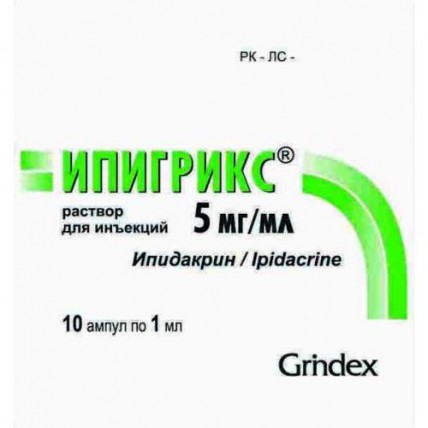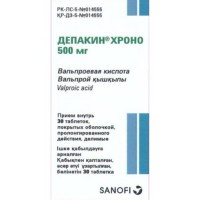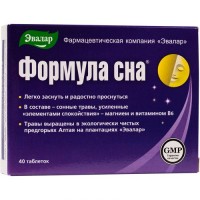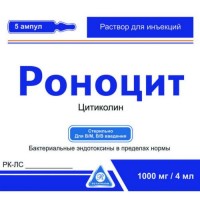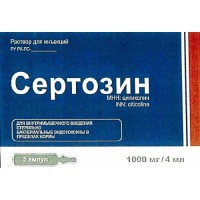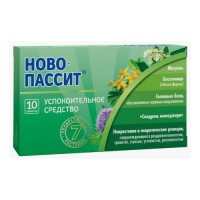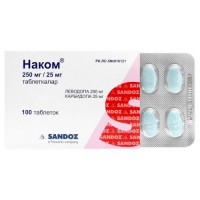IPIGRIX 5 mg / ml 1 ml 10s injection
- $46.90
Out Of Stock
The instruction for medical use of IPIGRIKS medicine the Trade name of IPIGRIKS the International unlicensed name Ipidakrin Lekarstvennaya a form Solution for injections of 5 mg/ml and 15 mg/ml Structure of 1 ml of drug contains active agent: an ipidakrina a hydrochloride (in terms of anhydrous substance) – 5 mg or 15 mg, excipients: acid of chlorohydrogen 1 M to pH 2.8-4.0, water for injections up to 1 ml. The description Transparent colourless solution Pharmacotherapeutic group Drugs for treatment of diseases of nervous system others. Antikholinesterazny drugs. The ATX N07AA code the Pharmacological Pharmacokinetics Later properties of parenteral administration of an ipidakrin a hydrochloride is quickly soaked up. The maximum concentration of active ingredient in blood plasma is reached in 25-30 minutes. Ipidakrin quickly gets from blood into fabrics, breaks a blood-brain barrier. After achievement of equilibrium distribution in blood plasma there are about 2% of active agent. It is generally metabolized in a liver by hydroxylation. Metabolites keep the same profile of action, but the expressiveness of their effects is much weaker. Elimination happens renalno and ekstrarenalno, removal with urine by canalicular secretion prevails, and only 1/3 doses are allocated by glomerular filtration. Final elimination half-life makes 2‑3 hours. After parenteral administration of 20-35% of a dose it is removed with urine in an invariable look, it does not kumulirutsya. The pharmacodynamics Ipidakrin is reversible inhibitor of cholinesterase. Ipidakrin directly stimulates carrying out impulses in central nervous system and in neuromuscular synapses, blocking potassium channels of membranes. Ipidakrin strengthens action on smooth muscles not only acetylcholine mediator, but also adrenaline, serotonin, a histamine and oxytocin. Main pharmacological effects of an ipidakrin: - restoration and stimulation of neuromuscular carrying out - restoration of carrying out an impulse in peripheral nervous system after the blockade caused by some factors (an injury, inflammation, effect of local anesthetics, some antibiotics, chloride potassium, etc.) - strengthening of contractility of smooth muscle bodies under the influence of all agonists, except chloride potassium - specific moderate stimulation of central nervous system in a combination with separate manifestations of sedative action - memory improvement Sufficient data of clinical trials of safety of use of this medicine for children are absent. Indications as a part of complex therapy - diseases of peripheral nervous system: mono - and polyneuropathy, polyradiculopathies, a myasthenia and a myasthenic syndrome of various etiology - a disease of the central nervous system: bulbar paralyzes and paresis - the recovery period in the organic lesions of the central nervous system which are followed by motive disturbances. The route of administration and doses of IPIGRIKS of 5 mg/ml and IPIGRIKS of 15 mg/ml enter solutions for injections intramusculary or subcutaneously. Doses and duration of treatment define individually depending on severity of a disease. Diseases of peripheral nervous system - mono - and polyneuropathy of various genesis: intramusculary or subcutaneously 1 ml of solutions for the injections containing 5 mg/ml or 15 mg/ml (5 mg or 15 mg), 1-2 times a day. A course of treatment − 10–15 days (in hard cases – up to 30 days). - myasthenia and myasthenic syndrome: intramusculary or subcutaneously 1 ml of solutions for the injections containing 5 mg/ml or 15 mg/ml (5 mg or 15 mg), 1-3 times a day. The general course of treatment makes 1-2 months. If necessary treatment can be repeated several times with a break between courses in 1-2 months. Diseases of the central nervous system - bulbar paralyzes and paresis: intramusculary or subcutaneously 1 ml of solutions for the injections containing 5 mg/ml or 15 mg/ml (5 mg or 15 mg), 1-2 times a day, a course of treatment makes 10-15 days. The recovery period in organic lesions of the central nervous system: intramusculary 1 ml of solutions for the injections containing 5 mg/ml or 15 mg/ml (5 mg or 15 mg), 1-2 times a day up to 15 days. Side effects Often - hypersalivation, nausea - heartbeat, bradycardia - the strengthened sweating Infrequently - the strengthened discharge of a secretion of bronchial tubes - after use of high doses – dizziness, a headache, weakness, drowsiness, muscular spasms, allergic reactions (skin itching, rash), vomiting - disturbance of a respiratory system Seldom - pain in epigastriums, diarrhea Is unknown (it is impossible to determine by the available data) - a bronchospasm - a miosis - a tremor - a hypothermia, stethalgias In these cases reduce a dose or quickly (for 1-2 days) interrupt administration of drug. The specified side effects are observed seldom and usually are not the reason of drug withdrawal. It is possible to reduce hypersalivation and bradycardia mkholinoblokator (atropine, etc.). Contraindications - hypersensitivity to an ipidakrin or to drug excipients - epilepsy - extrapyramidal diseases with a hyperkinesia - stenocardia - the profound bradycardia - bronchial asthma - impassability of intestines or urinary tract - tendency to vestibular disorders - a peptic ulcer of a stomach or duodenum in an aggravation stage - the period of pregnancy and feeding by a breast - children's and teenage age up to 18 years (adequate researches on studying safety of medicine at children are not conducted) the Presence of sedation in a range of activity of an ipidakrin leads Medicinal interactions to some potentiation of effects of somnolent drugs (hexenal, Chlorali hydras) in high doses while in small doses ipidakrin either does not influence, or weakens effect of hypnotic drugs. Action and side effects amplify at combined use with other inhibitors of cholinesterase and m - cholinomimetic means. At patients with a myasthenia the risk of developing cholinergic crisis against the background of use of other cholinomimetic means increases. Beta blockers increase risk of developing bradycardia if were applied prior to treatment ipidakriny. Cerebrolysinum increases efficiency of drug. Ipidakrin weakens effect of local anesthetics, antibiotics. Alcohol enhances side effects of drug. Special instructions If the next dose is not entered, it is necessary to enter it whenever possible rather, but it is no more than appointed single dose. It is impossible to enter a double dose for substitution of the passed dose! With care to appoint in a thyrotoxicosis, diseases of a serdechnososudisty system, respiratory diseases in the anamnesis and in acute respiratory diseases. Features of influence of medicine on ability to run the vehicle or potentially dangerous Ipidakrin mechanisms can have sedative effect therefore it is necessary to refrain from driving and work with dangerous mechanisms. Overdose At heavy overdose the development of cholinergic crisis with symptoms is possible: a bronchospasm, lachrymation of eyes, the strengthened sweating, narrowing of pupils, a nystagmus, spontaneous defecation and urination, vomiting, bradycardia, heart block, arrhythmias, hypotension, concern, alarm, excitement, sensation of fear, an ataxy, convulsions, a coma, the illegible speech, drowsiness and weakness. Symptoms can be mild. Treatment: drug withdrawal, symptomatic therapy, use of mkholinoblokator (atropine and Cyclodolum) which reduce expressiveness of symptoms of overdose. A form of release and packing On 1 ml in an ampoule from colourless glass I of a hydrolytic class with two marking rings yellow and red (for a dosage of 5 mg/ml) or green and red (for a dosage of 15 mg/ml) colors and with the line or a point of a break. On 5 ampoules in blister strip packaging from a polyvinylchloride film without covering (pallet). On the 2nd blister strip packagings (pallet) together with the instruction for medical use in the state and Russian languages place in a pack from cardboard. To Store storage conditions at a temperature not above 25 °C. Not to freeze! To store out of children's reach! 2 years not to apply a period of storage after an expiration date. Prescription status According to the prescription HBM Producer of Pharm of neuter of the lake of St. of Sklabinsk, 30, Martin, 036 80, Slovakia the Owner of the registration certificate of JSC Grindex. Krustpils St., 53, Riga, LV-1057, Latvia
to Develop the Address of the organization accepting in the territory of the Republic of Kazakhstan claims from consumers on quality of the products responsible for post-registration observation of safety of medicine Representative office of JSC Grindex 050010, Almaty, Dostyk Ave., a corner of Bogenbay St. of the batyr, 34a/87a, office No. 1
to Develop the Address of the organization accepting in the territory of the Republic of Kazakhstan claims from consumers on quality of the products responsible for post-registration observation of safety of medicine Representative office of JSC Grindex 050010, Almaty, Dostyk Ave., a corner of Bogenbay St. of the batyr, 34a/87a, office No. 1
